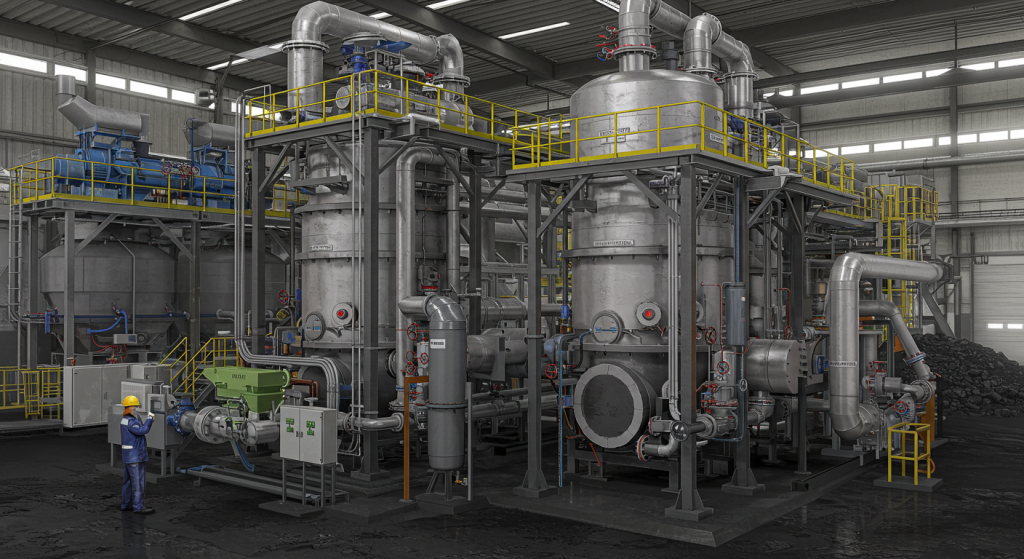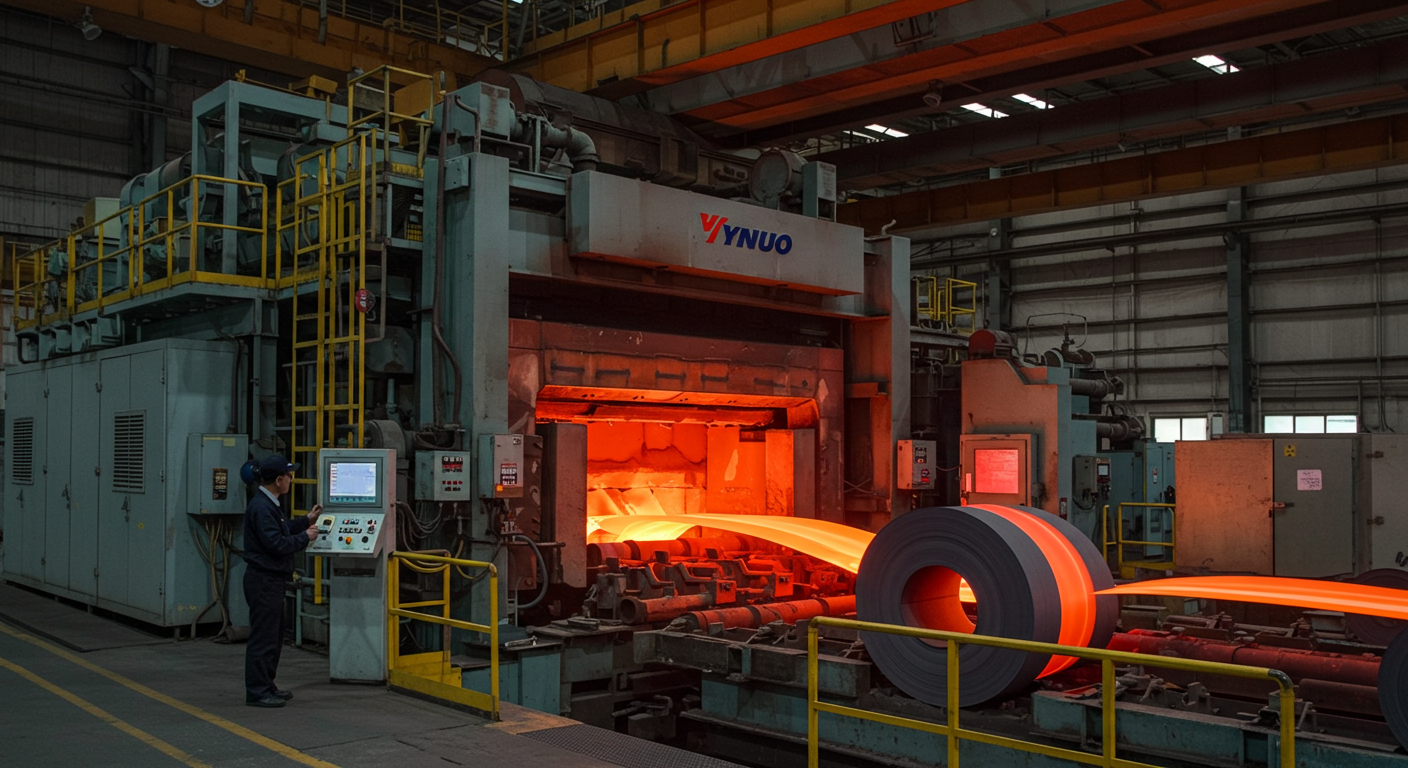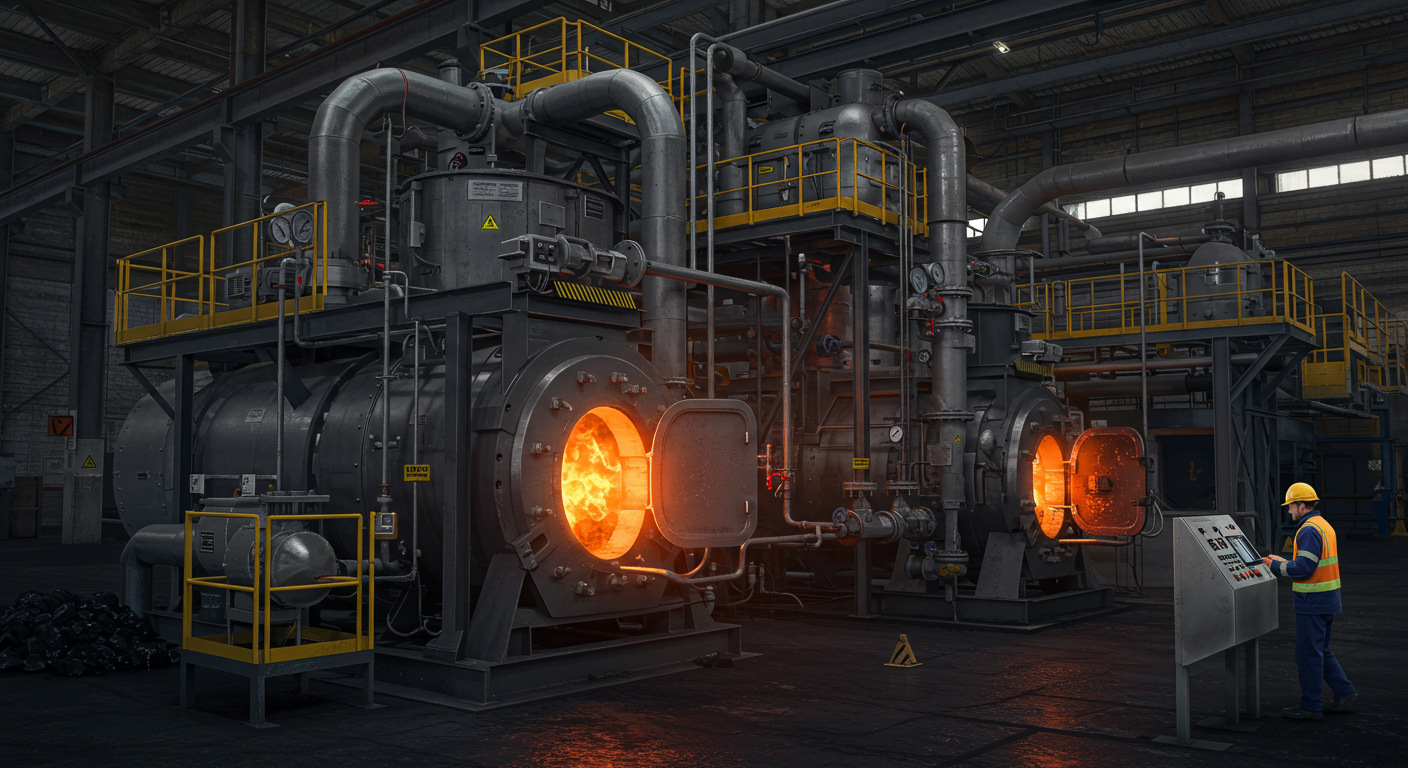
Two-stage coal gasifiers represent a significant advancement in gasification technology, offering improved efficiency and cleaner syngas production compared to traditional single-stage systems. By separating the gasification process into two distinct reaction zones, these systems optimize coal conversion, reduce tar and pollutant emissions, and enhance syngas quality for diverse applications. Jiangsu Yinuo Thermal Energy Technology Co., Ltd., based in Xuzhou, China, stands as a global leader in thermal energy solutions, including advanced gasification systems. This guide explores the technology, applications, and benefits of two-stage coal gasifiers, detailing their role in modern industrial processes with a focus on efficiency, environmental performance, and versatility.
Understanding Two-Stage Coal Gasifier Technology
Two-stage coal gasifiers operate by dividing the gasification process into two sequential reaction zones, typically a high-temperature combustion or pyrolysis stage followed by a lower-temperature gasification stage. This approach allows for better control of reaction conditions, higher carbon conversion rates, and reduced tar content in the syngas, which consists primarily of carbon monoxide (CO), hydrogen (H₂), and sometimes methane (CH₄). Operating at temperatures between 1100°C and 1700°C and pressures up to 4.0 MPa, these systems are designed for efficiency and scalability, suitable for both small and large-scale industrial applications.
Core Components
A two-stage coal gasifier features a robust reactor vessel, often constructed from stainless steel with refractory linings to withstand extreme temperatures. The first stage, typically a high-temperature combustion or pyrolysis zone, includes burners or nozzles for injecting coal, oxygen, and steam, achieving temperatures around 1500–1700°C. The second stage, a gasification or reduction zone, operates at lower temperatures (1100–1200°C) and introduces additional coal or steam to optimize syngas production. Gas cleanup systems, such as cyclones, wet scrubbers, or electrostatic precipitators, remove tar, particulates, and sulfur compounds. Feed systems, like screw conveyors or slurry pumps, ensure consistent coal input, while control systems with PLCs or microcomputers regulate temperature, pressure, and gas flow. Ash and slag handling systems, including water quenches or ash hoppers, manage byproducts.
Operational Mechanism
In the first stage, pulverized coal or coal slurry is injected with oxygen and steam into a high-temperature zone, where partial combustion or pyrolysis occurs, producing a hot gas mixture rich in CO, H₂, and char, along with molten ash (slag). The high temperature ensures slag withdrawal, as it exceeds the ash melting point, preventing agglomeration. This hot gas and char enter the second stage, where additional coal or steam is introduced, cooling the gas to 1100–1200°C and promoting endothermic gasification reactions (e.g., C + H₂O ↔ H₂ + CO). These reactions increase H₂ and CO yields, reducing tar and methane content. The syngas is cooled, cleaned, and directed to downstream applications, such as power generation or chemical synthesis, while slag is removed as an inert, vitreous byproduct.
Key Applications of Two-Stage Coal Gasifiers
Two-stage coal gasifiers serve a variety of industries, leveraging their high-efficiency syngas production for energy and chemical applications. Their ability to handle diverse coal types, including high-ash or low-rank coals, makes them versatile for global markets.
Power Generation
Two-stage coal gasifiers are integral to Integrated Gasification Combined Cycle (IGCC) power plants, where syngas fuels gas turbines for electricity generation, with exhaust heat driving steam turbines. The dual-stage design improves thermal efficiency, achieving up to 48% compared to 30–40% for conventional coal plants, as seen in projects like Japan’s Nakoso IGCC plant. This application supports clean power generation with reduced emissions, particularly when paired with carbon capture systems.
Chemical Feedstock Production
Syngas from two-stage gasifiers serves as a feedstock for producing chemicals like methanol, ammonia, and dimethyl ether (DME). In China, projects like the Datang International Duolun Coal Chemical Project utilize large-scale two-stage gasifiers to produce chemicals from lignite, demonstrating the technology’s scalability. The high H₂/CO ratio of syngas from these systems is ideal for ammonia synthesis in agriculture or methanol for industrial solvents.
Industrial Heating and Fuel Gas
In industries such as steel or cement manufacturing, syngas from two-stage gasifiers provides a clean, high-calorific-value fuel for heating or process gas. The low tar content (e.g., 52 ± 3 mg/Nm³ in some systems) ensures compatibility with burners, reducing maintenance compared to single-stage gasifiers. This application supports cost-effective, localized energy solutions in coal-rich regions.
Hydrogen Production
The hydrogen-rich syngas produced by two-stage gasifiers can be further processed to extract H₂ for fuel cell applications or industrial processes. Research, such as that conducted by NeuRizer in China, highlights the potential for underground coal gasification (UCG) using two-stage systems to produce hydrogen, offering a pathway for clean energy in coal-dependent economies.
Benefits of Two-Stage Coal Gasifiers
Two-stage coal gasifiers offer distinct advantages, addressing the needs of industries prioritizing efficiency, environmental performance, and operational flexibility. Their advanced design delivers performance tailored to modern energy and chemical production demands.
Enhanced Syngas Quality
The two-stage process segregates pyrolysis/combustion and gasification, reducing tar content to as low as 52 ± 3 mg/Nm³ and increasing calorific value to 9.5–11 MJ/kg, as demonstrated in novel designs for high-ash coal. This high-quality syngas is suitable for gas turbines, engines, or chemical synthesis, minimizing downstream cleanup costs.
High Carbon Conversion
Carbon conversion rates reach up to 98.9%, with cold syngas efficiency of 83.2% at 3.0 MPa, as reported in studies of two-stage entrained-flow gasifiers. The dual-stage design ensures efficient char gasification, maximizing fuel utilization and reducing waste compared to single-stage systems.
Environmental Performance
Lower tar and methane content reduce emissions of pollutants like sulfur oxides and particulates, aligning with environmental regulations. The technology facilitates CO2 capture, with IGCC systems achieving capture rates above 91%, supporting cleaner coal utilization, as noted in Chinese IGFC projects.
Feedstock Flexibility
The ability to process diverse coals, including high-ash or low-rank varieties, enhances operational versatility, particularly in regions like China and India with varied coal reserves. Recent designs, such as the novel two-stage system for high-ash coal, prevent ash agglomeration, expanding feedstock options.
Technical Advantages of Two-Stage Coal Gasifiers
Two-stage coal gasifiers incorporate advanced features that optimize performance, syngas quality, and sustainability, addressing the challenges of industrial gasification.
Optimized Reaction Zones
The high-temperature first stage (1500–1700°C) ensures slag withdrawal by exceeding ash melting points, while the second stage (1100–1200°C) promotes efficient gasification reactions, reducing oxygen consumption and increasing H₂ yield. This dual-zone approach, as studied in full-scale two-stage gasifiers, enhances syngas efficiency.
Advanced Gas Cleanup
Cyclone reactors in the first stage segregate oxidative pyrolysis, minimizing tar formation, while packed bed reactors in the second stage optimize char gasification, as highlighted in recent high-ash coal gasifier designs. Integrated cleanup systems, like pressure swing adsorption for H2S and CO2 removal, ensure clean syngas for downstream use.
Robust Reactor Design
Refractory-lined reactors with water-cooled walls or quench systems handle high temperatures and pressures, ensuring durability. Multi-nozzle burner configurations, as used in ECUST’s opposed multi-burner (OMB) gasifiers, improve reactant mixing, enhancing carbon conversion and operational stability.
Automation and Control
PLC-based control systems with IoT integration enable real-time monitoring of temperature, pressure, and gas composition, optimizing reaction conditions. Automated feed systems and gasifying agent controls, as seen in two-stage entrained-flow gasifiers, ensure consistent performance, reducing operational complexity.
Industry-Specific Considerations
Different industries require tailored two-stage coal gasifier configurations to meet specific process and feedstock demands, ensuring optimal performance and cost efficiency.
Power Generation and IGCC
IGCC plants prioritize high-efficiency gasifiers with low tar content for gas turbine compatibility. Two-stage gasifiers, like those in the Nakoso IGCC plant, achieve 48% thermal efficiency, requiring robust cleanup systems and high-pressure operation (up to 4.0 MPa) to maximize power output.
Chemical Production
Chemical applications demand hydrogen-rich syngas, favoring gasifiers with high H₂/CO ratios. Two-stage systems with steam injection in the second stage, as in the Datang Duolun project, optimize methanol or ammonia production, requiring precise atmosphere control to prevent contamination.
Industrial Heating
Industrial heating applications require low-tar, high-calorific-value syngas for burners. Down-draft or cyclone-based first stages, as in novel two-stage designs, minimize tar, while packed bed second stages ensure clean gas, supporting steel or cement manufacturing.
Hydrogen and Emerging Markets
Hydrogen production favors gasifiers with high H₂ yields, as seen in NeuRizer’s UCG projects. Two-stage systems with CO2 capture integration support clean hydrogen for fuel cells, requiring advanced gas separation and high-pressure operation.
Challenges and Solutions
Two-stage coal gasifiers face challenges like tar management, high costs, and environmental impact, but recent advancements address these issues effectively.
Tar and Pollutant Management
High tar levels in the first stage can foul downstream equipment. Cyclone or packed bed designs in the second stage, as in recent high-ash coal studies, reduce tar to below 52 mg/Nm³, while wet scrubbers or advanced filtration ensure clean syngas, minimizing maintenance.
High Capital and Operating Costs
Construction costs for gasification plants, particularly IGCC, are 35% higher than conventional coal plants, as noted in market analyses. Modular designs and optimized oxygen-to-coal ratios, as in ECUST’s OMB gasifiers, lower costs, improving economic viability.
Environmental Impact
CO2 emissions remain a concern, despite cleaner operation. Integration with carbon capture systems, achieving over 91% capture rates in IGFC projects, reduces emissions, while low-NOx burners and sulfur removal enhance environmental compliance.
Future Trends in Two-Stage Coal Gasifiers
The two-stage coal gasifier industry is evolving, driven by advancements in efficiency, sustainability, and integration with emerging technologies, shaping the future of clean coal utilization.
Advanced Gasifier Designs
Novel configurations, such as cyclone-packed bed reactors for high-ash coal, reduce tar and improve syngas quality, as demonstrated in recent research. Pressurized, multi-nozzle systems, like ECUST’s OMB gasifiers, enhance scalability for large-scale applications.
Carbon Capture and Utilization
Integration with carbon capture and storage (CCS) or utilization (CCU) technologies, as in Chinese IGFC projects, supports decarbonization, with capture rates exceeding 91%. This aligns with global net-zero goals, enhancing market appeal.
Hydrogen and Clean Energy
Two-stage gasifiers are increasingly focused on hydrogen production, as seen in NeuRizer’s UCG initiatives, supporting fuel cell and industrial applications. High H₂ yields and CO2 capture make these systems key to clean energy transitions.
Automation and Digitalization
AI-driven controls and IoT integration, though limited in current systems, enable real-time optimization and predictive maintenance, reducing costs and improving efficiency, as explored in recent gasification studies.
Choosing a Two-Stage Coal Gasifier
Selecting a two-stage coal gasifier requires evaluating application, feedstock, and operational needs to ensure performance and cost efficiency.
Key Considerations
Feedstock type, such as high-ash or low-rank coal, determines gasifier design, with two-stage systems offering flexibility. Application—power, chemicals, or hydrogen—dictates syngas composition and cleanup requirements. Production scale influences system size, with modular units suiting smaller plants. Energy efficiency, driven by regenerative burners and stage optimization, impacts costs. Maintenance and automation support ensure reliability.
Partnering with Jiangsu Yinuo
Jiangsu Yinuo’s team provides expert guidance, designing custom gasification solutions tailored to industrial goals. Installation and ongoing support ensure seamless performance, delivering precision and efficiency. Clients can explore solutions and connect through the Jiangsu Yinuo website for tailored options, backed by global expertise.
FAQ
What is the purpose of a two-stage coal gasifier?
Two-stage coal gasifiers convert coal into syngas for power generation, chemical production, or industrial heating, enhancing efficiency and reducing tar.
What feedstocks can two-stage coal gasifiers process?
High-ash coal, low-rank coal, and biomass blends are processed, supporting diverse industrial applications.
How is gasifier quality ensured?
Production involves rigorous testing of components, using premium materials, with compliance documentation meeting ISO and CE standards.
Are two-stage coal gasifiers customizable?
Gasifiers are tailored to specific feedstock, process, and production needs, with support from design to installation.
How energy-efficient are two-stage coal gasifiers?
Two-stage designs with regenerative burners achieve up to 83.2% cold syngas efficiency, reducing fuel use and costs.
How can a quote be requested from Jiangsu Yinuo?
A contact form, email, or phone inquiry through the Jiangsu Yinuo website provides a prompt response.
Conclusion
Two-stage coal gasifiers offer efficient, versatile solutions for syngas production, supporting power generation, chemical synthesis, and industrial heating with reduced emissions and high carbon conversion. Jiangsu Yinuo Thermal Energy Technology Co., Ltd. provides innovative, customized systems that empower industrial manufacturers globally. With advanced technology and a focus on performance, these gasifiers meet the demands of modern energy and chemical production. Explore solutions and connect through the website for a tailored quote to enhance production capabilities today.







